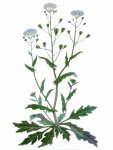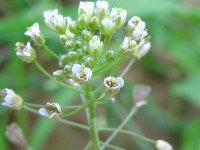Shepherd's purse
Capsella bursa pastoris (L.) Medic.
Botanical characteristics. Family cruciferous. Annual herbaceous plant up to 60 cm high. Root spindle-shaped, thin. Basal leaves are collected in a rosette, cauline leaves - regular, sessile, whole. White small flowers are collected in apical brushes. Blooms from April to September. Fruits - triangular pods, ripen in June-September.
Spread. Widespread plant. It grows throughout the country, except the Far North and deserts. It occurs as a weed in orchards, orchards, in fields, along roads, in wastelands.
Used parts of the plant.
The aboveground part.
In the grass contains vitamin K, bursic acid, tannins, rhamnoglikozid gissopina, tartaric, fumaric and malic acid, flavones, choline and acetylcholine, tyramine, inositol, saponins, phytoncides and ascorbic acid. In seeds - up to 28% of fatty oil and a small amount of allyl mustard oil.
Application.
The herb has antihypertensive, antipyretic, choleretic, astringent, diuretic and strong hemostatic effect.
It is used for hypertension and atherosclerosis. The leaves of the shepherd's bag as a vitamin remedy in spring are added to salads.
Infusions of herbs are prescribed for diseases of the gastrointestinal tract, with diarrhea, biliary and nephrolithiasis, kidney and bladder diseases, various metabolic disorders, gout and rheumatism.
Basically shepherd's bag is used as a good hemostatic agent for various internal bleeding: uterine, gastric, pulmonary, renal. Infusions of herbs as a hemostatic agent are prescribed for uterine cancer.
Outer infusions are used for injuries and bruises in the form of lotions.
Contraindications. Pregnancy.
Preparation. Infusion is prepared based on 3 tablespoons of herbs for 2 cups of boiling water (insist in a thermos - a daily dose).





Comments
When commenting on, remember that the content and tone of your message can hurt the feelings of real people, show respect and tolerance to your interlocutors even if you do not share their opinion, your behavior in the conditions of freedom of expression and anonymity provided by the Internet, changes Not only virtual, but also the real world. All comments are hidden from the index, spam is controlled.